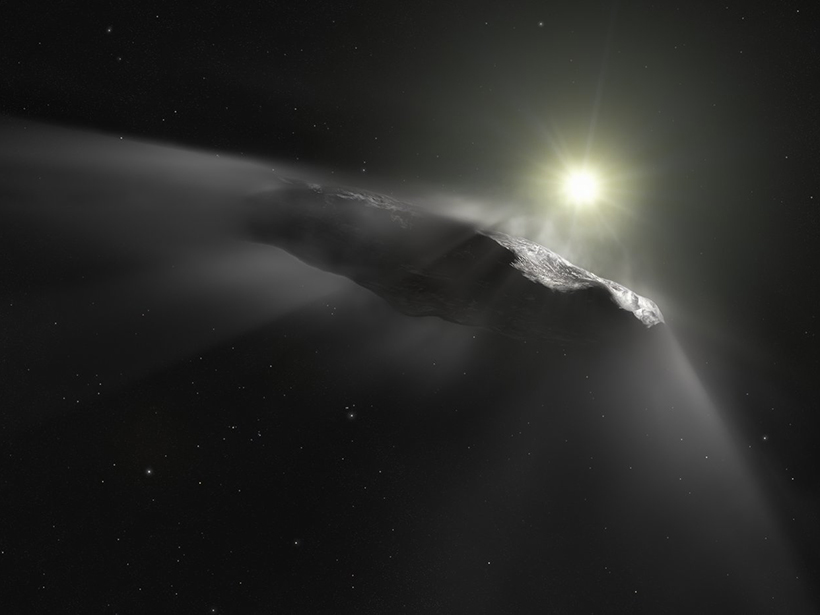Life from Earth could spread beyond the solar system if an interstellar visitor skimmed our planet’s atmosphere and picked up microbial hitchhikers. In fact, although the odds are slim, it’s possible Earth has already sent out a slew of these natural probes.
Most research on panspermia, the idea that life could be carried from one world to another, focuses on the blunt-force approach: If a large enough rock slams into a planet infected with life, smaller debris could be blown off world, carrying microorganisms into space, where they could eventually collide with other worlds. But with the recent discovery of two interstellar interlopers, ‘Oumuamua and Borisov, a new question emerged: Could objects like these have scooped up life from Earth’s atmosphere and carried it back out of the system?
“We might have sent thousands of Voyager probes already—thousands of rocks that were laden with Earth microbes.”
It’s possible, according to new research from Amir Siraj, an undergraduate at Harvard University, and Harvard theoretical astrophysicist Avi Loeb. Their studies suggest that objects kicked out of other planetary systems, as well as long-period comets from our own solar system, could have potentially hit the atmospheric sweet spot that would allow them to carry microorganisms beyond the heliosphere.
“How many objects could have come just close enough not to hit Earth but just to pick up microbes along the way?” asked Siraj.
Siraj said that he expected the answer would be zero. Instead, his research revealed that as many as 50 interstellar objects could have buzzed Earth over our planet’s lifetime before leaving the solar system for good. As many as 10 long-period comets, born in the solar system and freed by the gravitational pull of passing stars, could also have escaped with life.
“We’ve sent the Voyager probes,” Siraj said, referring to the 1970s human-made satellites on their way out of the solar system carrying information about Earth’s life. “But in fact, we might have sent thousands of Voyager probes already—thousands of rocks that were laden with Earth microbes.”
Catching a Ride
To pick up terrestrial hitchhikers, a comet would need to zip through the upper atmosphere where microorganisms have been detected by other studies but not dip low enough to burn up or collide with our planet. Previous studies have found microorganisms up to 50 kilometers above Earth’s surface, with at least one study identifying them as high as 77 kilometers. For passing comets hoping to pick up a few microbes, higher altitude is better because the lower the comet dips, the more friction it will encounter and the more likely it is to burn up without escaping Earth’s gravitational grasp.
This not-too-high, not-too-low sweet spot changes with the size and density of the objects. Larger, denser objects could survive a trip through regions lower than their more fragile counterparts.
Although hitting that sweet spot can be a challenge, it’s not impossible. Several atmospheric grazing events have been reported since the 1970s, the most recent being a fireball over the Australian desert in 2017. Such fireballs could have scooped up life as they passed through.
Escaping the Solar System Is Just a Start
The optimistic upper atmosphere measurements should be taken with caution, warns Manasvi Lingam, an astrobiologist at the Florida Institute of Technology. Although several studies have found microorganism colonies at altitudes of 50 kilometers, only a single published experiment has identified them at almost 80 kilometers. That experiment hasn’t been replicated since it was performed in 1978. “It’s a somewhat controversial paper,” Lingam said. That doesn’t mean the research was wrong, he said, only that it needed to be independently verified. “Until we have another subject that corroborates the results, we just need to be cautious about using those older studies.”
Siraj didn’t seem overly concerned, pointing out that his team was mostly interested in finding out if the process itself was possible. He expressed optimism that studies like his might spur further investigation into how high microorganisms could survive in the atmosphere.
Hitching a ride is only the first step. Once microorganisms were outside the solar system, radiation from other stars could quickly put an end to any terrestrial life that managed to escape the solar neighborhood. That’s why comets, both local and interstellar, make such good transportation. With their icy surfaces, comets are extremely porous, allowing microorganisms to burrow or be pushed into the depths rather than riding on the surface. Tucked away inside, life could be shielded from harmful radiation by its transportation.
“It’s hard to know what would happen to the microbes,” Lingam said, pointing out that there are few studies on how much protection the icy surface provides from radiation. “If they do make it closer to the center of the object, deep inside the object, I think they would be quite fine. It really depends on how many of them can burrow to a deeper layer.”
The next step, of course, would be colliding with another habitable planet where the microorganisms could flourish. Although the odds of that aren’t covered by the current paper, Siraj said he hopes to study the subject in the near future.
Impacts remain the dominant method for carrying life off Earth, but Earth-grazing objects could provide a significant addition. “This is a very small subset, but perhaps one of the most important,” Siraj said.
The new research was published in the International Journal of Astrobiology.
—Nola Taylor Redd ([email protected]; @NolaTRedd), Freelance Science Journalist
Citation:
Redd, N. T. (2020), Interstellar visitors could export terrestrial life to other stars, Eos, 101, https://doi.org/10.1029/2020EO138856. Published on 22 January 2020.
Text © 2020. The authors. CC BY-NC-ND 3.0
Except where otherwise noted, images are subject to copyright. Any reuse without express permission from the copyright owner is prohibited.

